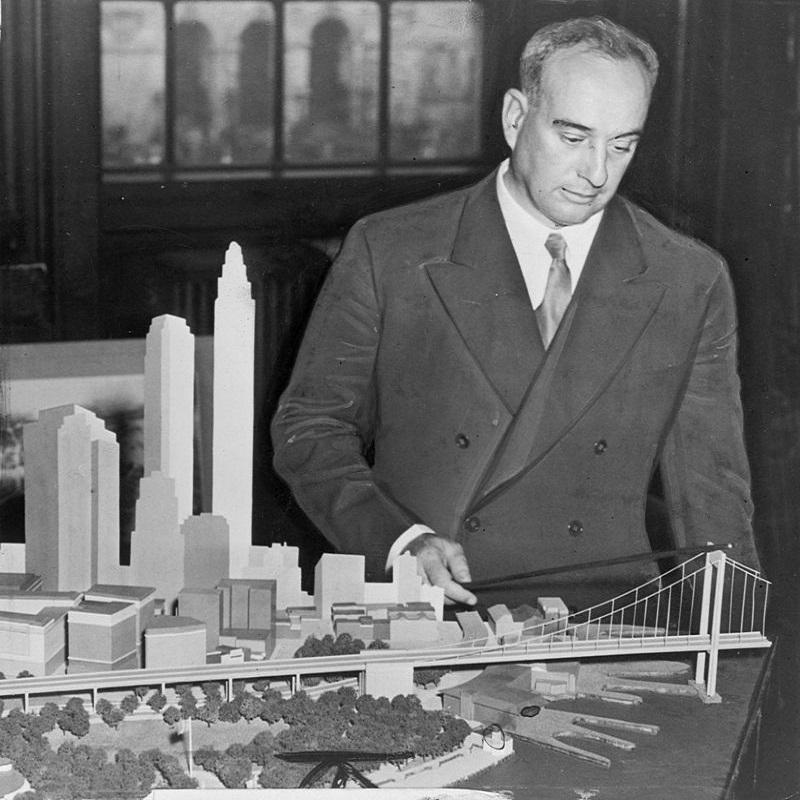Robert Moses Vs. Jane Jacobs: A Story Of David And Goliath
By | November 1, 2022

Robert Moses was never elected to any political office, but because of his work as an urban planner, he became one of the most powerful individuals in the New York City and State government. His work on the infrastructure of New York as well as his philosophy of urban development influenced the work of urban planners, engineers, and architects for years. Over the course of his 40-year career, he controlled millions of dollars in revenue he had various positions, and had up to 12 different titles simultaneously at points. These titles included New York City Parks Commissioner and Chairman of the Long Island State Park Commission. He managed to work with little outside oversight, and because he worked closely with New York Governor Al Smith, he learned how to write laws and manipulate the inner workings of state government.
He Changed New York
His construction projects in New York transformed the metropolitan area, and he was responsible for the New York State Parkway System as well as the bridges and tunnels in New York City. His projects had some negative results, however. Because he built expressways through traditional neighborhoods, these neighborhoods were destroyed. Some of his projects contributed to the ruin of the South Bronx and of Coney Island. They helped to precipitate the departure of the Brooklyn Dodgers and the New York Giants baseball teams.
The Attempted Highway Through Greenwich Village
In 1955, he wanted to build a highway through Washington Square Park, the historic center of Greenwich Village. When Jane Jacobs read a flyer about Moses’s proposed roadway through the center of the park, she became an activist and set out to stop him. She organized the community, getting everyone from local schoolchildren to Eleanor Roosevelt involved in the fight. She also contributed her positive visions of a “teeming city” in a 1958 article in Fortune. This would lead to her masterwork, The Death and Life of American Cities.

Trying To Declare Greenwich Village Blighted
About a month after Jacobs finished her manuscript, New York City’s Housing and Redevelopment Board was working to reclassify part of Greenwich Village south of Washington Square Park as “blighted.” Although Moses was not personally responsible for the effort, his associates were, and the reclassification of the area would have allowed him to build his highway. Jacobs then became the co-chair the Committee to Save the West Village, and they set out to rebut the “blighted” designation.
Jacobs Was An Organizer
As mandated by law, public hearings were required, and Jacobs obtained an order from the state judge to ensure they took place. Moses used a tactic he had often used: scheduling public hearings at short notice to thwart mobilized resistance. Luckily, Jacobs had a source at City Hall who kept her informed, so she was able to organize significant support to storm the meetings. She as also able to uncover additional sneaky tactics on the part of the real estate company that was to redevelop the area, and eventually the city was forced to abandon the “blighted” designation.
They Wanted To Raze SoHo Too
The fight was not over, however, as they were trying to extend the 10 lanes of Interstate 78 from the Holland Tunnel to the Manhattan and Williamsburg Bridges. To do so, they needed to contend with the obstacle of SoHo and Little Italy. They proposed to demolish 416 buildings to clear the way. These buildings were architecturally significant, and had one of the greatest collections of cast-iron architecture in the world. Jacobs had to fight an expressway that was supported by the Regional Plan Association, the American Institute of Architects, the Municipal Art Society, business groups, and construction workers’ associations.

The Protests Continued
Jacobs assembled a diverse group to stop the construction, comprised of Puerto Ricans, Italians, intellectuals, workers, and possibly the mafia. They used both short- and long-term tactics, such as obtaining delays for resident relocation and holding rallies. To emphasize the likely increase in pollution from the highway, residents donned gas masks to dramatize the situation.
Jacobs Was Arrested
In 1962, the city’s mayor, Robert F. Wagner halted the proceedings. However, with a new proposal to submerge part of the expressway, and pressure from Moses, the highway was reborn. The new mayor, John Lindsay opposed the expressway prior to election, but he switched his position, and instead, tried to make the expressway construction palatable. At a public meeting, Jacobs led protestors onto the stage and was jailed for a night.
She Won The Battles And The War
In 1969. Because of situations in her personal life, Jacobs left New York, but Mayor Lindsay declared the expressway plans scrapped the next summer. Within the same year, Governor Nelson Rockefeller dissolved Moses’s final bastion, the Triborough Bridge Authority. Meanwhile, Jacobs went on to have a successful career as an author and urbanist.